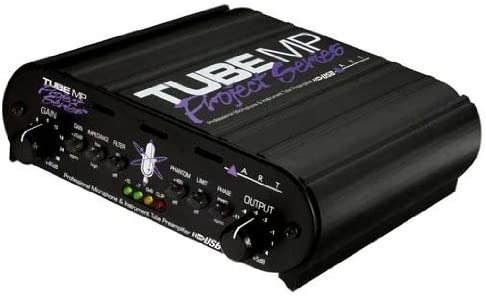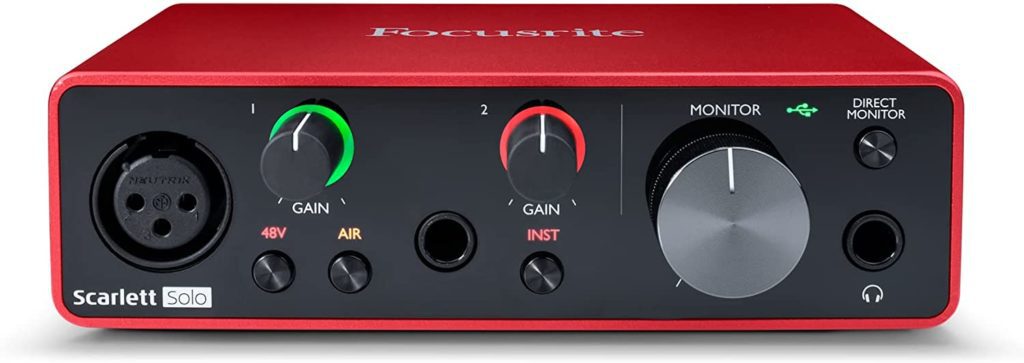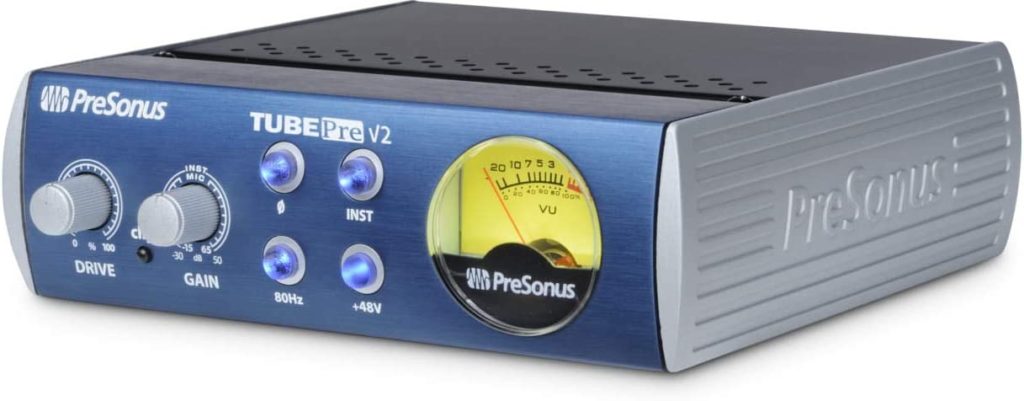I think that there is probably no need for an explanation of how important the mic preamp is for the recording process. And if you think that only the top-level rich studios can flex around with the best quality mic preamps, you are wrong!
In the article down below you will find the best microphone preamps under $500 that will surprise you with their quality. And in case you don’t find what you’re looking for, there is another article about the best microphone preamps in previous years.
Our Top Picks:
| Item | Main information | Number of inputs | |
|---|---|---|---|
| Provides the number of the professional mic preamps features | 2 | https://amzn.to/3RSOKF5 |
| Provides the clear sound and a number of the professional mic amplifier features | 2 | https://amzn.to/3HLQDic |
Rockville PPA52 | Provides the range of the AUXconnectors, can connect via USB and Bluetooth | 4 | https://amzn.to/3jTKY1N |
ART ProMPAII Two Channel Discrete Class A Microphone Preamp
This preamplifier might seem a little bit bulky and old-fashioned at first sight, but in reality, it’s a high-quality studio-grade mic preamp. As you can see from the title, it features independent channels of amplification.
For those new to the subject, it makes it perfect for any type of studio recording. Therefore, the level of quality of this amp is super decent and it’s also significant for its flexible functionality and wide dynamic range.
Actually, it’s one of the best options for its price that’s why I placed it as number one.
There are not so many items at this price that can bring you so many benefits. Initially, this item is designed so you could have all the features a studio engineer could ever need in a microphone preamplifier.

It has the XLR and jacks inputs so you can plug pretty much any type of instrument into the preamp. In addition to all of that, here you will find a number of pro features, for example, phase inversion, phantom power, and variable Independence.
The item also has a high pass filter that can be extremely useful when you need to control the excessive base frequencies and manage the proximity effect of microphones.
You can even create fantastic extra wide recordings with its mid/side matrix. This microphone preamplifier can help you to achieve a wide range of tones and it includes a nice analog sound because of the tubes in utilization.
I think it’s fair enough to claim that this gear will be suitable for any type of music genre. It shows the best performance each time and doesn’t matter how complicated the task is.
The last but not least advantage of this item is the lettering since it provides both VU style meters and LEDs allowing you to measure accurately your audio levels.
Pros:
- High-quality, tube sound
- Two separate channels for stereo recordings
- A wide range of professional features
- Fantastic metering
- Flexible controls, great dynamic range
- A number of inputs and outputs
Cons:
- Would be nice to see a boosting EQ
You may also like: Best microphones for podcasting
Warm Audio WA12 MKII
This next preamplifier that we have looks a little bit simple, but don’t be fooled by its looks. Actually, it’s one of the most popular devices in studios all around the world. It is a small but effective amplifier that can provide superb sound quality.
In addition to that, it always comes with a robust set of features and provides a huge amount of value. And all of that comes at a very reasonable price. This preamplifier will bring a magical touch to your recordings.
Its range of features includes a HI-Z mode, a gain-reducing pad, and phase inversion.

The measuring here is highly responsive and gives you enough information so you could accurately gain stage your settings while working with the relatively common LED strip.
The sound that you will get in the end will be rich with minimal noise and brilliant harmonics. It is actually a motor unit but it also offers XLR and 1/4 inches inputs, so you can connect it to pretty much any kind of music device.
And as you can see from the picture, the unit has a smaller rack mount design. Of course, this picture could make it a little bit awkward to fit into some gear racks, but still, there shouldn’t be any significant issues.
Pros:
- Brilliant sound
- A range of useful pro features
Cons:
- Small size
- Basic metering and controls
Rockville PPA52
This is another one of the most popular budget preamps sing the music world and it’s a basic workhorse. If you are not looking for anything super fancy without any vintage tube tile sound then this is a nice option.
I mean, it gets the job done and it includes a good range of controls. It’s coming in the familiar 19 inches right now format. Its connectivity of it is simply excellent and includes a huge range of RCA aux inputs. There are also 1/4 in instrument jacks.
The item also offers stereo outputs along with the aux and recording outputs. Those allow you to split the signal paths. There’s also the headphone output for monitoring the process.

The pure sound of this amplifier isn’t something marvelous so I could write paragraphs about it. But the remarkable thing is that this item comes with a three-band equalizer, and each equalizer has its own control knob for boosting or cutting.
Here you will find such controls as Bass, Mid, Treble, Mic gain, and stereo balance.
Pros:
- A range of Aux connections
- Optional Bluetooth and USB-enabled models are available
- Decent equalization controls
Cons:
- No XLR Input
- Average sound quality.
ART Tube MP USB Microphone Preamp
If everything you need is a small microphone preamplifier then this item from ART Electronics is a great choice. This is a single-channel mic preamp for those who do not need much but need a well-working and reliable product.

This preamp also doubles as a USB outer interface and that means that you can use this model to record directly to your PC. The preamp itself is very sturdy and it’s made from plastic and aluminum materials.
It also has an LED display and quite precise measurements. It’s also a quiet and affordable item, but don’t expect miracles from it because of its price.
So in case, you’re looking not for power, but rather simply an extremely durable microphone preamplifier, ART Electronics is definitely a choice.
Pros:
- Works as an audio interface
- Limiter to prevent clipping
- Pro features and sound in a small package
Cons:
- A small item with limited possibilities
You may also like: 9 Best XLR audio-cables for microphones
Focusrite Scarlett Solo
This pre-amplifier doesn’t seem that significant from the beginning but in fact, it’s an absolute classic of the amateur production scene. If you’ve ever been a Home music producer, you probably owned one of these at some point.
It is a decent microphone preamplifier/USB audio interface that combines modern teachers and easy functionality. Users of every level will be able to handle this pre-amplifier no matter if it’s a pro or beginner.
This amplifier has separate channels for XLR mix and 1/4 inches instruments. It means that you can record two sources at once.

The quality of the overall thing is going to be great because the Focusrite brand is the subsidiary of Neeve which is quite famous in the world of music.
The two balanced outputs also provide clean audio playback with their low-noise features. This amplifier could also work well for guitar recordings since it causes almost no distortion or unwanted clipping during the process.
One of the additional advantages of this preamp is that it comes in a number of different colors!
I would definitely recommend this pre-amplifier to beginners. It’s one of the best affordable devices on the market. Actually, it was one of my first preamps when I just started recording.
Pros:
- Reputable Focusrite quality
- Works as an audio interface
- Air boost adds detail to the top end of recordings
Cons:
- Relatively limited
PreSonus STUDIOCHANNEL Vacuum-Tube Channel Strip
If you’re looking for a studio-quality make pre-amplifier but don’t want to spend too much money on it, pay attention to this item. This is a high-quality, 19 inches rackmount mic preamplifier by PreSonus.
As you can see from the picture, the unit looks quite impressive and it also offers a broad range of features. As the result, it is capable to create a clean, high-fidelity sound. This amplifier uses tube circuitry for maximum analog tone.
In addition to that, it boasts a parametric equalizer along with a completely configurable compressor. I would even say that this is not just another microphone preamplifier but this is the complete Studio Channel.

With its help, you will be able to take your recordings to the next level. In general, this preamp is suitable for vocals, dynamic acoustic piano, solid bus guitar, and acoustic guitar.
It also contains the high pass filter and features the polarity reverse that lets you tweak your signals to sit properly in the mix.
For some of you, it might be a good make pre-amplifier to start from but only if you already have some experience with the music gear. It really covers the basics with its equalizer, and it also has a very handy compressor and options.
The only thing is the manufacturer doesn’t really provide clear instructions on the exploration.
Pros:
- High-fidelity tube sound
- Built-in EQ and compressor
- Superb functionality
- Profesional sound quality
Cons:
- Short manuals
You may also like: Best microphones for streaming
Presonus TubePre v2 Tube Preamplifier DI Box
At first sight, this microphone preamplifier looks like a toy, and in fact, it’s not the most professional music gear, but it’s able to provide everything you need to boost and color a microphone.
It comes at a grade affordable price and it includes the low-noise dual servo. It also has a separate instrument and makes outputs that help to improve the overall quality of this sound.

And we are quite surprised that it also provides phantom power, HP filter, and polarity reverse. As we already mentioned, the dual servo gain stage allows you to boost the signal to smoking-hot levels without significantly increasing noise.
Such discreet components and I will touch operation with the dynamic range and details are rare to be found in the segment of the single channel tube preamps. This item delivers incredibly high headroom, deep lows, smooth highs, and rich sound waves.
The preamp is housed in a rugged case which makes it easy to travel with. It includes the XLR input for the microphone and unbalanced 1/4 inches outputs. Therefore, it’s compatible with a number of devices and it’s suitable for any type of recording.
Pros:
- Adjustable gain and saturation
- Small format
- Versatile
- Great sound quality
Cons:
- Some features are still limited due to the price
FAQ for Microphone Preamps Users:
1. What Is A Microphone Preamp?
A microphone preamp is an electronic device that amplifies the signal from a microphone before it is sent to the sound recording device or mixer. The preamp acts as an intermediary between the microphone and the recording device, providing clean and consistent sound quality by boosting weak signals, reducing noise, and helping improve clarity.
2. What Are The Benefits Of Using A Microphone Preamp?
A microphone preamp can offer significant gains in sound quality by giving your recordings more clarity, depth, and fullness. It can also help reduce background noise, making sure that only your desired sound is being recorded.
Additionally, most preamps offer different settings for different types of recording situations (ie: voiceover work, live performance, etc) allowing you to customize your sound based on what type of recording you are doing.
3. Which Preamp Is Best For Beginners?
The best preamp for beginners depends on budget and application type. Generally speaking, low-priced models under $500 tend to be well-suited for novice users because they provide adequate levels of amplification without breaking the bank.
It’s important to consider what type of recording you plan to do before selecting a model – some are better suited for studio use while others may be more appropriate for live performances or broadcasting applications.
4. Are Microphone Preamps Necessary For Home Recording Setup?
Having a good microphone preamp in your home recording setup is essential if you want to get professional-level results from your recordings.
Without one, you won’t be able to get optimal sound quality or capture subtle nuances in your audio tracks that would usually require a higher-end model with additional features such as EQ controls or limiters, etc.
Preamps also provide additional protection against distortion or unwanted background noise which can be detrimental when it comes to producing high-quality recordings at home.
5. How Do I Connect My Microphone To A Preamp?
Connecting a microphone to a preamp is relatively easy but does vary depending on the specific model you’re using and what type of connection ports it has available (XLR or TRS).
With most devices it just requires plugging your mic into the right socket – usually located at the back of the device – then connecting another lead from the output side of your preamp into either an audio interface or sound card which will then send the signal to your computer software for further processing/editing etc


